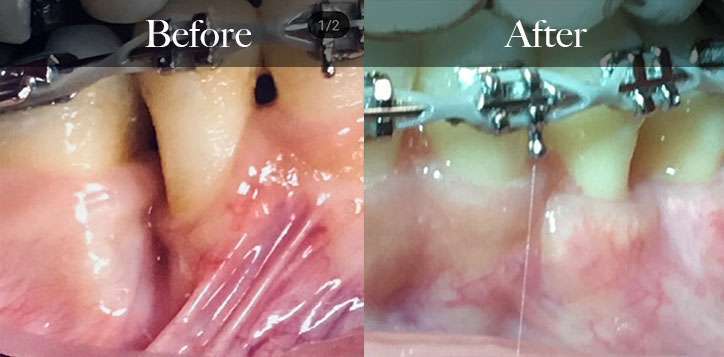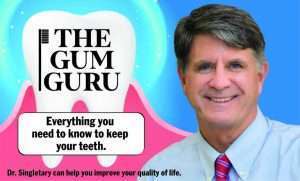
When patients first seek treatment at North Raleigh Periodontics, many complain of sensitivity to hot and cold, pain, and discomfort in their gums. Most often these symptoms occur as a result of gingival recession at the gum line. The untreated, harmful buildup of oral bacteria causes this gum recession by breaking down the gum tissue. Over time, sensitivity and pain at the gum line will occur, the teeth will become mobile, and, if untreated, the teeth will fall out. Here at North Raleigh Periodontics, we treat the surrounding structures of the teeth. In short, we improve gum tissue health which helps you maintain your teeth with comfort and functionality. Sometimes, regenerative treatment is necessary to restore the vitality of the gums and connective tissue surrounding and supporting the teeth.
Regenerative treatment is achieved through gingival grafts. Though the idea of undergoing a gingival graft sounds daunting and perhaps scary, in fact, it is a fairly simple, swift procedure that offers great success in the regeneration of recessed and diseased gingiva. There are a number of techniques that I can utilize to optimize the successful restoration and healing of recessed gums; the method I choose depends largely upon the thickness and viability of the specific patient’s surrounding gums and upon the patient’s oral health.
There are four types of grafts that I primarily use: (1) connective tissue graft, (2) free soft tissue autogenous grafts, (3) double papillae subepithelial connective tissue grafts, and (4) pedicle grafts.
A connective tissue graft is the most common method used to cover the exposed tooth roots, which if remain exposed give rise to discomfort and sensitivity. For this procedure, I first create a pouch in the present tissue on the front of the tooth. Then I incise a small flap in the oral palate and remove a thin layer of subepithelial tissue from underneath the flap. I place the connective graft tissue in the pouch to cover the exposed tooth root, and by osmosis the pouch feeds the connective tissue graft over the root. Finally, I stitch the flap on the roof of the mouth back down.
A free soft tissue autogenous graft is similar to a connective tissue graft, except that instead of pulling a thin layer of subepithelial tissue from underneath the flap incision, a small bit of tissue is removed directly from the roof of the mouth. I use this technique for patients with thin gums who require extra thickness in the recessed area.
A third type of graft, the double-papilla subepithelial connective tissue graft (DPSE graft) is not as complicated as it sounds. This technique is used when there is no attached gingiva on the tooth; in other words, there is no gum tissue connecting the tooth to the mucogingival junction. Furthermore, there is significant gum recession in the tooth at issue, although the surrounding teeth possess healthy gums.
For the first part of the procedure, I make two incisions in the papilla- the gum tissue in between the teeth. The “double-papilla” of the DPSE graft is so-named because I make the incision of the healthy papilla on either side of the from either side of the recessed tooth. I then lift the papillae slightly, in preparation to place subepithelial tissue underneath.
I continue the DPSE procedure by making a small flap in the roof of the mouth and removing a bit of subepithelial tissue, which I then place next to the recessed tooth, underneath the raised double papillae, to cover the exposed bone of the tooth. Finally, from there I connect the papillae from either side of the surrounding teeth in the middle of the tooth with a single stitch. This allows the tissue to meet in the middle and cover the subepithelial tissue that I took from the roof of the mouth and placed over the root and bone.
The fourth graft technique that I frequently utilize is known as the pedicle graft. Along with the DPSE graft, this graft requires that the gums of the teeth surrounding the recessed area are healthy. Instead of taking the tissue from the roof of the mouth, the pedicle flap is only partially detached from either above or below the tooth, or from either side, depending on where the recession is located. I take the partially detached tissue, pull it vertically or horizontally to cover the exposed root, and stitch it into place. When it heals, the stretched tissue re-gains the same density as the surrounding tissue.
These techniques are a few of many that I employ to give each patient the greatest possible success in the regeneration of his or her periodontia. I strive to make sure that whatever technique I choose, it is best suited for the individual’s specific periodontal needs.
We are always here to help you. Please don’t hesitate to call us at (919) 518-8222 if you have any questions.
 For more information on this topic, listen to the Gum Guru Podcast by clicking the link below:
For more information on this topic, listen to the Gum Guru Podcast by clicking the link below:
When You Should Be Alarmed By Gum Recession
